RECORD NUMBER OF FOOD LAWSUIT FILINGS FLOOD COURTS
This year, New York is on pace to break the 2020 record of 183 consumer class action filings. In 2020, more food-related lawsuits pervaded New York courts than the next four states combined. According to the New York Civil Justice Institute, consumer class actions in New York tripled between 2017 and 2020, largely due to food and beverage lawsuits, which accounted for approximately 60% of such claims in 2020. Through June 30, 2021, 77 food marketing class actions were filed in New York.
Plaintiffs’ lawyers regularly abuse the vague language of New York’s consumer protection law (GBL §349), which does not require a plaintiff to demonstrate that the business intentionally misled consumers or that a consumer actually relied on the misrepresentation to her detriment. Although a plaintiff must demonstrate that a practice is “likely to mislead a reasonable consumer acting reasonably under the circumstances,” many New York courts have refused to assume that a reasonable consumer consults a nutrition label. 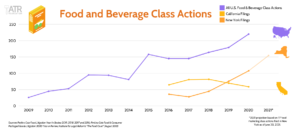
The plaintiff may recover actual damages or $50, whichever is greater, and courts may triple actual damages up to $1,000 if the defendant knowingly or willfully engaged in the deceptive act.
In June 2021, the New York Court of Appeals expanded the application of the state’s consumer protection law to a business setting. The high court held that directing conduct to a “subclass of consumers” is sufficient to satisfy the statutory requirement that a defendant’s conduct was consumer-oriented, because the defendant’s conduct was not limited to “a private contract dispute, unique to the parties.” In other words, a defendant’s conduct does not need to be directed at all members of the public to satisfy the first element of the law.
Previous precedent defined consumers as those “who purchase goods and services for personal, family, or household use,” but in this case, defendants sold an annual treatise on New York tenant law, a book meant for business use. According to the state’s high court, it is immaterial that the conduct was only directed to legal professionals because “GBL §349 is focused on the seller’s deception and its subsequent impact on consumer decision-making, not on the consumer’s ultimate use of the product.” Thus, GBL §349 applies to products used exclusively in a business setting, not just products used for personal or household use.
Worse yet, the legislature is considering a bill that would encourage even more frivolous consumer protection lawsuits. A. 2495A/S. 6414 expands the consumer protection law to prohibit not only “deceptive” acts, but also “unfair” or “abusive” acts, increases the minimum statutory damages from $50 to $2,000 and permits unconnected third-party organizers to sue for the alleged harm, even if the alleged violation is not consumer oriented.
“Vanilla Vigilante” Finds New Targets
Infamous Long Island attorney Spencer Sheehan, also known as the “Vanilla Vigilante,” continues to prolifically file lawsuits specializing in product flavoring. Sheehan filed half of the state’s consumer class action lawsuits in 2019 and almost two thirds in 2020.
2021 has been no different. In January, he filed a lawsuit on account of 7-Eleven’s marketing of “Yumions.” According to Sheehan, the bag features a depiction of a green onion, but the snack only contains onion powder, which does not provide the same health benefits as real onions. The complaint stated: “Since each part of the onion – bulb, root, stem, and skin – has unique flavor and aroma compounds, onion powder necessarily is unable to provide the ‘oniony’ flavor appreciated by consumers.”
He also filed another suit on account of Whole Foods’ marketing of “Lemon Raspberry Italian Sparkling Mineral Water,” which the lawsuit claims misleads consumers into believing that the product contains an appreciable amount of lemon and raspberry. This lawsuit was voluntarily dismissed in August 2021.
In April 2021, Sheehan & Associates reached a settlement with Blue Diamond on behalf of a proposed class of consumers who purchased Almond Breeze vanilla-flavored products. The settlement, valued at approximately $2.6 million, awards cash payments of up to $1 per item with proof of purchase, and $0.50 per item without proof of purchase. Plaintiffs’ lawyers could receive as much as $550,000 for fees and costs, while the named plaintiffs would share $25,000.
In October 2021, Sheehan targeted Pop-Tarts’ classic strawberry toaster pastry. The plaintiff sought $5 million, claiming that the company’s marketing of its strawberry pop-tart deceived consumers because the pastry contains higher quantities of pears and apples than strawberries.
Good News
In June 2021, U.S. District Judge Raymond J. Dearie dismissed a consolidated proposed class action brought by Sheehan against Mars Wrigley. Plaintiffs alleged that Mars Wrigley violated New York’s consumer protection laws by marketing its vanilla-flavored ice cream bars as “vanilla” because consumers are misled to believe that the product is flavored exclusively by vanilla beans. Judge Dearie found that plaintiffs failed to demonstrate that “a reasonable consumer acting reasonably under the circumstances would be misled by the phrase ‘vanilla ice cream’” because “[t]his case, like the litany of vanilla cases before it, is about flavor and there is no allegation that the ice cream bars do not taste like vanilla.”
Since mid-2019, Sheehan & Associates P.C. has filed virtually identical complaints against, and forced quick settlements with, Nestle, Friendly’s, Blue Diamond, Califia, Trader Joe’s, and others.
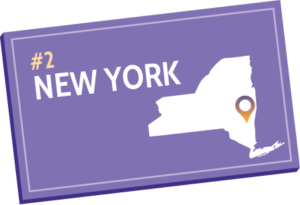 New York’s race to the bottom (or the top) of the Judicial Hellholes® list continued in 2021, as the state’s leadership seems intent on creating the worst legal climate in the nation. The gap between California and New York is narrow, as the two jurisdictions battle it out for the most “no-injury” class action lawsuits targeting the food and beverage industry and the most claims under the Americans with Disabilities Act. The two states also have activist attorneys general trying to regulate industries through litigation.
New York’s race to the bottom (or the top) of the Judicial Hellholes® list continued in 2021, as the state’s leadership seems intent on creating the worst legal climate in the nation. The gap between California and New York is narrow, as the two jurisdictions battle it out for the most “no-injury” class action lawsuits targeting the food and beverage industry and the most claims under the Americans with Disabilities Act. The two states also have activist attorneys general trying to regulate industries through litigation.


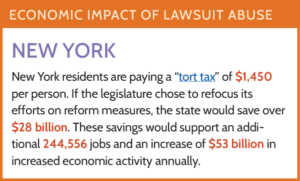
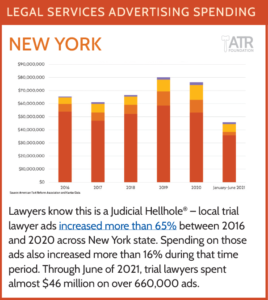

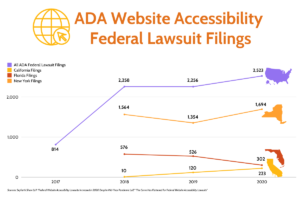
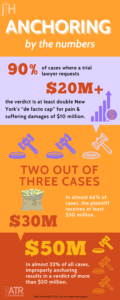 New York is experiencing a surge of “nuclear verdicts” in cases ranging from premise liability to medical malpractice. These are awards that usually include an amount for pain and suffering that dwarfs prior verdicts and, at levels in the tens of millions of dollars, hardly serve a compensatory purpose. Rather, they result from improper tactics that inflame jurors and mislead them to believe that amounts at these levels are ordinary and acceptable in litigation.
New York is experiencing a surge of “nuclear verdicts” in cases ranging from premise liability to medical malpractice. These are awards that usually include an amount for pain and suffering that dwarfs prior verdicts and, at levels in the tens of millions of dollars, hardly serve a compensatory purpose. Rather, they result from improper tactics that inflame jurors and mislead them to believe that amounts at these levels are ordinary and acceptable in litigation.

